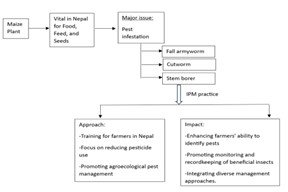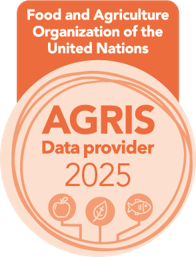Comparative analysis of knowledge and management practices of insect pests of maize among IPM adopters and non-adopters in Sindhupalchok, Nepal
Abstract
Integrated pest management (IPM) is a decision-based approach that involves optimizing the pest population below the economic threshold by the coordinated use of multiple tactics in an economically and environmentally sound manner. The adoption of IPM in farming practices prevents long-term pest damage by combining biological control, modification of cultural practices, habitual manipulation, and use of resistant varieties. In Nepal, mostly in hilly regions, haphazard chemical pesticide application has inevitable effects on human health, the environment, and the ecosystem. The haphazard chemical pesticide application in Sindhupalchok, Nepal originated mostly due to a knowledge gap in the identification of the stages of the lifecycle of pests, and the distinction between beneficial and harmful insects. To compare the effectiveness of management practices between IPM adopters and non-adopters this study was framed for six months in Sangachokgadi municipality, Sindhupalchok, Nepal. The knowledge gap among the maize growers in Sindhupalchok was assessed using both primary and secondary data collection methods. For primary data collection a comprehensive and structured questionnaire, face-to-face interview, phone call interview, and Key Informant Interview was conducted. Similarly, secondary data was collected from various articles and publications from Maize Zone, the Ministry of Agriculture and Livestock Development (MoALD), Nepal Agriculture Research Council (NARC), and National Maize Research Program (NMRP). The collected data were then analyzed (descriptive statistics, chi-square test, and indexing) by using computer software packages i.e., Statistical Package for Social Science (SPSS) version 26, and Microsoft Excel 2010. The analyzed data revealed maize growers adopting IPM practices for crop management are known to have significantly better knowledge of the life cycle of pests, were able to distinguish between beneficial and harmful insects, and had knowledge of appropriate fertilizer doses. Further, the findings revealed IPM adopters had better knowledge of chemical pesticide handling which could minimize the chemical hazards among the farmers.
Keywords:
Fall armyworm, IPM, KAP, Maize, Smallholder farmersDownloads
References
Ansari, M. S., Moraiet, M. A., & Ahmad, S. (2014). Insecticides: Impact on the Environment and Human Health. Environmental Deterioration and Human Health: Natural and Anthropogenic Determinants, 9789400778, 99–123. https://doi.org/10.1007/978-94-007-7890-0_6
Bhandari, G. S., Thapa, R. B., Giri, Y. P., Manandhar, H. K., Jha, P. K., Maize, N., & Plaza, S. (2019). 85 Research Article. Journal of Agriculture and Forestry
University, 3, 85–97.
Bista, S., Thapa, M. K., Khanal, S., & Kumari Thapa, M. (2020). Sustainable agriculture View project New Research project for plant species. View project Fall armyworm: Menace to Nepalese farming and the integrated management approaches. Article in International Journal of Agriculture Environment and Biotechnology, 5(4). https://doi.org/10.22161/ijeab.54.21
Czapar, G. F., Curry, M. P., & Gray, M. E. (1995). Survey of Integrated Pest Management Practices in Central Illinois. Journal of Production Agriculture, 8(4), 483–486. https://doi.org/10.2134/jpa1995.0483
Ehler, L. E. (2006). Perspectives Integrated pest management (IPM): definition, historical development and implementation, and the other IPM.
https://doi.org/10.1002/ps.1247
Erbaugh, J. M., Donnermeyer, J., Amujal, M., & Kidoido, M. (2010). Assessing the Impact of Farmer Field School Participation on IPM Adoption in Uganda Abstract. Journal of International Agricultural and Extension Education, 17(2005), 1–12.
Erbaugh, J Mark, Donnermeyer, J., & Kibwika, P. (2001). Evaluating Farmers’ Knowledge and Awareness of Integrated Pest Management (IPM): Assessment of the IPM Collaborative Research Support Project in Uganda.
FAO & CIMMYT. (2018). Integrated management of the Fall Armyworm on maize A guide for Farmer Field Schools in Africa. FAO, 130. http://www.fao.org/3/I8665EN/i8665en.pdf
Flint, M. L. (2012). IPM in Practice, 2nd Edition: Principles and Methods of Integrated Pest ... - Mary Louise Flint - Google Books. https://books.google.com.np/books?hl=en&lr=&id=4MtgeUgjwNcC&oi=fnd&pg=PP2&dq=What+are+the+physical+methods+of+IPM&ots=a_ggQxnK7y&sig=nt1LTSX33OxBpHDkcAzxeprABSE&redir_esc=y#v=onepage&q=What are the physical methods of IPM&f=false
Gautam, I. P. (2008). Evaluation of Cucumber Genotypes for Open Field and Plastic House in the Western Hills of Nepal. Proceedings of the Third SAS-N Convention. https://www.researchgate.net/publication/312023993
Ghimire, N. P. (2005). IMPACT OF AGRICULTURAL AGGRAVATION ON ECOLOGY. 106–114.
Gogi, D., Sufyan, M., Nawaz, A., & Sarfraz, R. M. (2017). Principles of Insect Pest Management. https://www.researchgate.net/publication/329979611
Haddi, K., Turchen, L. M., Viteri Jumbo, L. O., Guedes, R. N. C., Pereira, E. J. G., Aguiar, R. W. S., & Oliveira, E. E. (2020). Rethinking biorational insecticides for pest management: unintended effects and consequences. Pest Management Science, 76(7), 2286–2293. https://doi.org/10.1002/PS.5837
HIRAI, Y. (1991). Major pests of maize and control measures in Japan. Jarq-Japan Agricultural Research Quarterly, 25(1), 12–16.
Kandel, B. P. (2021). Status, prospect and problems of hybrid maize (Zea mays L.) in Nepal: a brief review. Genetic Resources and Crop Evolution, 68(1).
https://doi.org/10.1007/s10722-020-01032-0
Kapse, P., Ps, K., Rd, A., & Pr, D. (2018). NASF Project on “Addressing Farmers Suicide Issues through Capacity Building of the Farming Families” View project Centre of Excellence for Digital Farming Solution for Productivity Enhancement by Robots, Drones and AGVs View project Knowledge and adoption of integrated management of white grub among the farmers. Journal of Pharmacognosy and Phytochemistry, 7(5), 1100–1103. https://www.researchgate.net/publication/327792856
Katan, J. (2000). Physical and cultural methods for the management of soil-borne pathogens. Crop Protection, 19(8–10), 725–731. https://doi.org/10.1016/S0261-2194(00)00096-X
Kenis, M., Hurley, B. P., Hajek, A. E., & Cock, M. J. W. (2017). Classical biological control of insect pests of trees: facts and figures. Biological Invasions, 19(11), 3401–3417. https://doi.org/10.1007/S10530-017-1414-4/FIGURES/9
Khanal, U., Wilson, C., Shankar, S., Hoang, V. N., & Lee, B. (2018). Farm performance analysis: Technical efficiencies and technology gaps of Nepalese farmers in different agro-ecological regions. Land Use Policy, 76(February), 645–653. https://doi.org/10.1016/j.landusepol.2018.02.045
Mamun, M. S. A., & Ahmed, M. (2011). Integrated pest management in tea: prospects and future strategies in Bangladesh. https://www.researchgate.net/publication/236944121
McIntosh, H., Atucha, A., Townsend, P. A., Hills, W. B., & Guédot, C. (2022). Plastic mulches reduce adult and larval populations of Drosophila suzukii in
fall-bearing raspberry. Journal of Pest Science, 95(1), 525–536. https://doi.org/10.1007/S10340-021-01456-2/FIGURES/4
Midega, C. A. O., Murage, A. W., Pittchar, J. O., & Khan, Z. R. (2016). Managing storage pests of maize: Farmers’ knowledge, perceptions and practices in western Kenya. Crop Protection, 90, 142–149. https://doi.org/10.1016/J.CROPRO.2016.08.033
MoALD. (2019). sTaTisTiCal inforMaTion nepalese agriCulTure.
Morse, S., & Buhler, W. (1997). Integrated pest management: ideals and realities in developing countries. Lynne Rienner. https://www.cabdirect.org/cabdirect/abstract/19996778199
Moss, S. (2019). Integrated weed management (IWM): why are farmers reluctant to adopt non-chemical alternatives to herbicides? Pest Management Science, 75(5), 1205–1211. https://doi.org/10.1002/ps.5267
Ndakidemi, B., Mtei, K., & Ndakidemi, P. A. (2016). Impacts of Synthetic and Botanical Pesticides on Beneficial Insects. Agricultural Sciences, 07(06), 364–372. https://doi.org/10.4236/AS.2016.76038
Pandey, P. R., Pandey, H., & Nakagawa, M. (2009). Assessment of Rice and Maize Based Cropping Systems For Rural Livelihood Improvement in Nepal. Journal of Agriculture and Environment, 10, 67–75. https://doi.org/10.3126/aej.v10i0.2131
Paudyal, K. R., Ransom, J. K., Rajbhandari, N. P., Adhikari, K., Gerpacio, R. V., & Pingali, P. L. (2001). Maize in Nepal: production systems , constraints , and priorities for research. In Cimmyt,Narc.
Peshin, R., & Zhang, W. (2014). Integrated Pest Management and Pesticide Use. Integrated Pest Management: Pesticide Problems, Vol.3, 1–46.
https://doi.org/10.1007/978-94-007-7796-5_1
Pingali, P. L., Marquez, C. B., Palis, F. G., & Rola, A. C. (1995). The Impact of Pesticides on Farmer Health: A Medical and Economic Analysis in the Philippines. Impact of Pesticides on Farmer Health and the Rice Environment, 343–360. https://doi.org/10.1007/978-94-011-0647-4_12
Ramzan, M., Hussain, S., & Akhter, M. (2007). Incidence of Insect Pests on Rice Crop Under Various Nitrogen Doses. System, 17(3), 35–37.
Schoelitsz, B., Meerburg, B. G., & Takken, W. (2019). Influence of the public’s perception, attitudes, and knowledge on the implementation of integrated pest management for household insect pests. Entomologia Experimentalis et Applicata, 167(1), 14–26. https://doi.org/10.1111/EEA.12739
Shah, K. K., Modi, B., Pandey, H. P., Subedi, A., Aryal, G., Pandey, M., & Shrestha, J. (2021). Diversified Crop Rotation: An Approach for Sustainable Agriculture Production. Advances in Agriculture, 2021. https://doi.org/10.1155/2021/8924087
Sharma, P. N., & Gautam, P. (1970). Assessment of Yield Loss in Maize due to Attack by the Maize Borer, Chilo partellus (Swinhoe). Nepal Journal of Science and Technology, 11(January 2011), 25–30. https://doi.org/10.3126/njst.v11i0.4085
Shelton, A. M., & Badenes-Perez, F. R. (2005). CONCEPTS AND APPLICATIONS OF TRAP CROPPING IN PEST MANAGEMENT. Annual Reviews, 51,
–308. https://doi.org/10.1146/ANNUREV.ENTO.51.110104.150959
Shields, M. W., Johnson, A. C., Pandey, S., Cullen, R., Chang, G.-, Wratten, S. D., & Gurr, G. M. (2018). History, current situation and challenges for conservation biological control. Biological Control. https://doi.org/10.1016/j.biocontrol.2018.12.010
Tang, S., Xiao, Y., Chen, L., & Cheke, R. A. (2005). Integrated pest management models and their dynamical behaviour. Bulletin of Mathematical Biology, 67(1), 115–135. https://doi.org/10.1016/j.bulm.2004.06.005
Timsina, K. P., Ghimire, Y. N., & Lamichhane, J. (2016). Maize production in mid hills of Nepal: from food to feed security. Journal of Maize Research and Development, 2(1), 20–29. https://doi.org/10.3126/jmrd.v2i1.16212
Wilson, C., & Tisdell, C. (2001). Why farmers continue to use pesticides despite environmental, health and sustainability costs. Ecological Economics, 39(3), 449–462. https://doi.org/10.1016/S0921-8009(01)00238-5

Published
How to Cite
Issue
Section
Copyright (c) 2024 Agriculture and Environmental Science Academy

This work is licensed under a Creative Commons Attribution-NonCommercial 4.0 International License.

